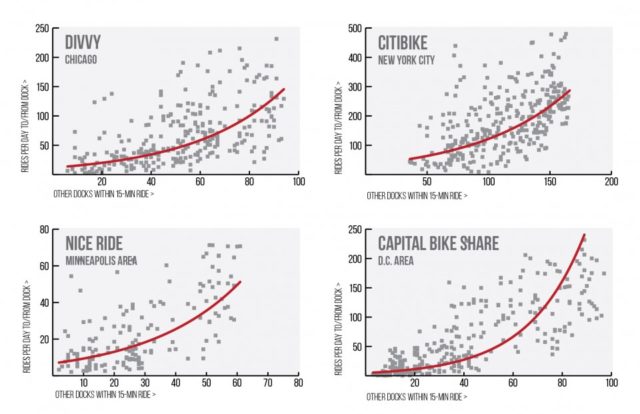NACTO Bike Share | Equity Practitioners’ Paper #1

Bike Share System Rides and Utility Increase with Station Density
Based on an analysis of ridership data from a variety of U.S. bike share systems, this report makes the connection between station density, service quality and equity, and provides a data-driven analysis for system operators looking to expand the reach and utility of their bike share systems. NACTO finds that the utility of a bike share system, as well as ridership numbers, increase exponentially when stations are closer together. To increase ridership among low-income populations, bike share systems must be designed to offer a meaningful transportation option. As cities seek to build successful, equitable bike share systems, NACTO finds that high station density – approximately 28 stations per square mile – and even station spacing – a station every 1,000 feet – is key.
The analysis identified five key lessons from reviewed bike share systems in Boston, Chicago, Minneapolis, New York City, and Washington DC:
» Equitable bike share systems must be planned to meet the service quality needs of low-income riders, including installing bike share stations at a walkable, high density across all neighborhoods in a service area, including low-income areas.
» In areas with less activity/population density, cities should reduce the station size, but maintain station spacing that ensures an even, walkable station density.
» Good bike share systems have lots of stations within a short walking distance and maintain that spacing across all neighborhoods.
» To increase ridership in low-income areas, cities should increase station density by adding infill stations (NACTO’s got guidance for this).
» Protected bike infrastructure must be introduced in tandem with bike share system launches and expansions to ensure that people of all ages and abilities will feel comfortable using the system.
Download Paper (PDF) >
NACTO’s Bike Share and Shared Micromobility Initiative >
Walkable Station Spacing is Key to Successful, Equitable Bike Share is the first in NACTO’s Equity Practitioners’ Paper series, which highlights best practices for cities aiming to address equity issues while introducing or expanding their bike share systems.
Read the rest of the Equity Practitioners’ Paper series:
Equity Practitioners’ Paper #2 | Can Monthly Passes Improve Bike Share Equity?
Equity Practitioners’ Paper #3 | Equitable Bike Share Means Building Better Places for People to Ride